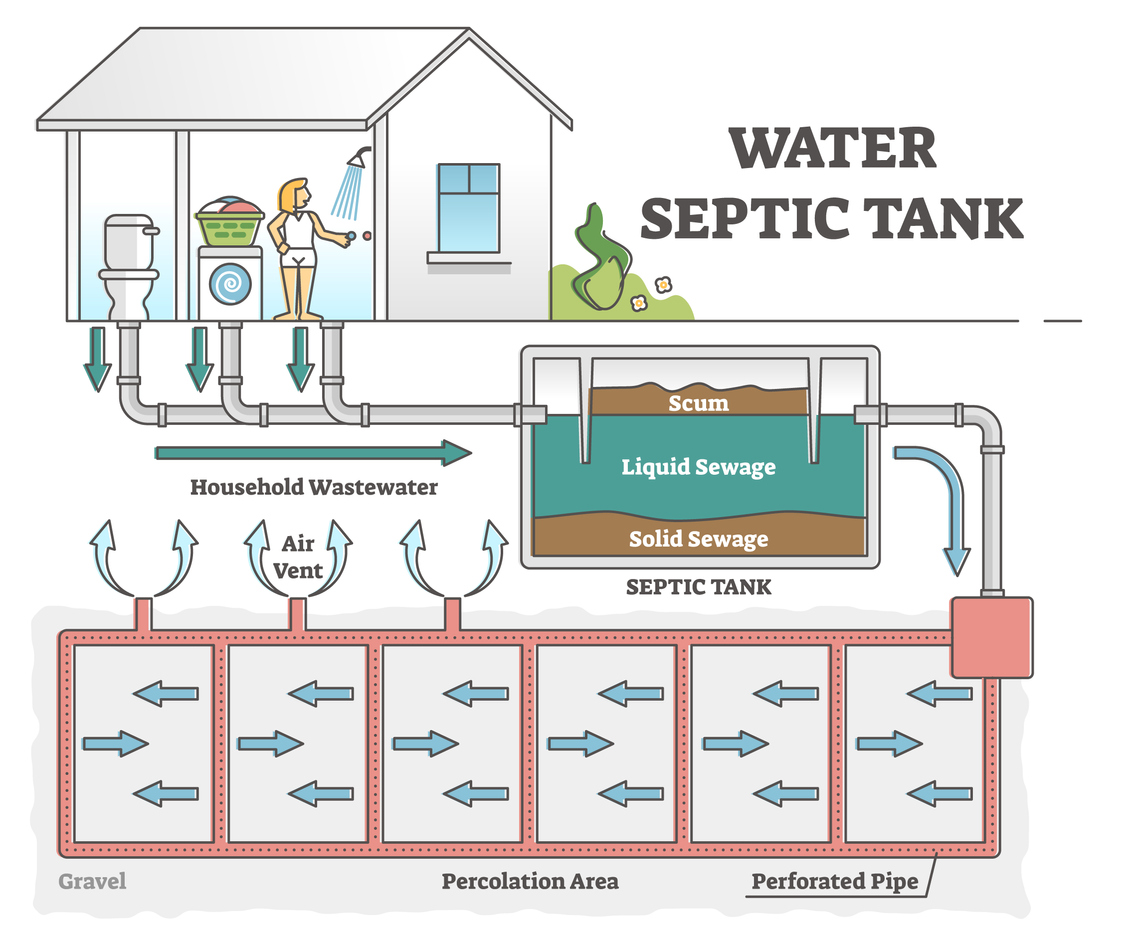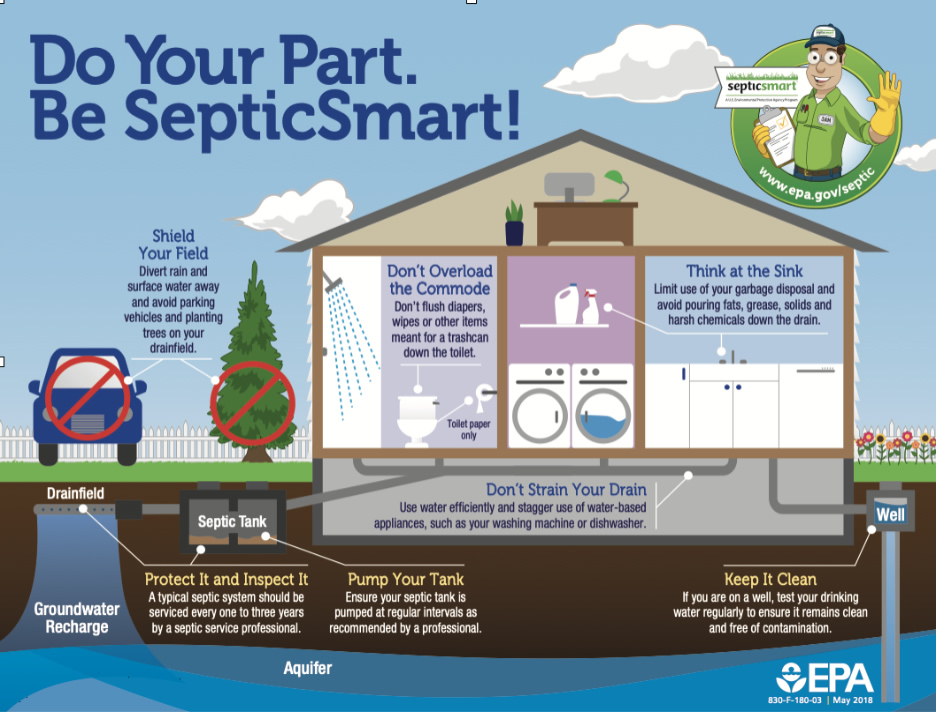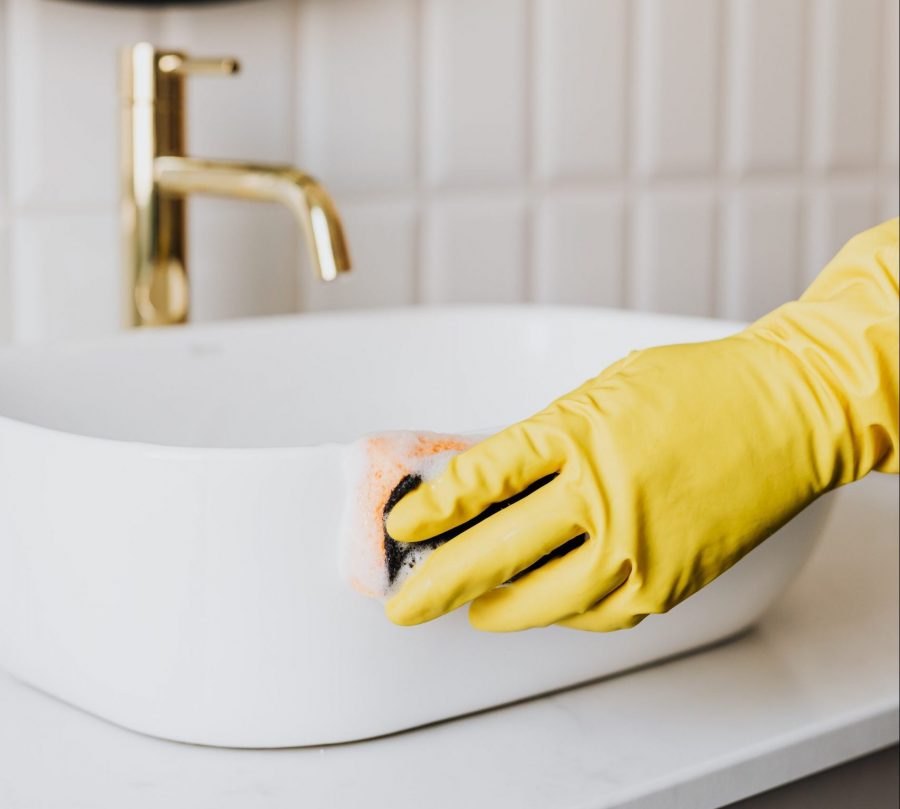Septic Systems & Watershed protection
Proper use and routine maintenance of septic systems are vitally important to watershed protection. To protect the health of our lakes and streams, it is critically important that people who live within the watershed’s boundary regularly inspect and maintain their septic systems. Follow our septic system maintenance tips below and “do your part…be septic smart!”
Inspect It & Protect It
Even properly functioning septic systems can allow harmful chemicals and damaging nutrients to seep into the ground where they can make their way to surface water and even drinking water.
All septic systems have a life span. Both old and new septic systems will last a long time if the microbes in the tank and drain field are not subjected to harsh chemicals and pharmaceuticals that kill the good bacteria that treat incoming wastewater. Consequently, newer systems can fail early if what is put down the drain is harmful or the volume of wastewater entering overpowers the system.
On the contrary, both old and new septic systems can function well for a long time if what is put down the drain is not harmful to the microbes that treat the wastewater. Also, if the volume of waste water matches the size of the system, this will bode well for it’s longevity.
But in the end, all drain fields – new and old will reach an endpoint where the soils and the microbes have lost their ability to treat wastewater properly and a new drain field will need to replaces the old one. A well used drain field should last around 25 years or more.
Homeowners can protect water quality by minding what goes down their drain and by having their septic system inspected regularly to ensure it is working properly.
SEPTIC SYSTEM BASICS
In a septic system, drainpipe carry wastewater to a large tank buried near the house. Solids in the wastewater settle to the bottom of the tank, while greases and oils float to the surface. Anaerobic bacteria in the tank (i.e., bacteria that thrive without oxygen) decompose these wastes into by-products such as carbon dioxide, methane, and water. Decomposed liquid waste flows from the septic tank into a drain field. The drainfield is where the wastewater soaks into gravel then migrates to the soil where remaining nutrients such as phosphorus and nitrogen, bind with minerals in the soil. Eventually this wastewater, having been treated by bacteria in the tank and by the soil adjacent to the drainfield, enters the groundwater where it becomes part of our drinking water and lake water supply.
Learn how to prevent your system from impacting nearby ground and surface water by referring to our tips below…
Tips For maintaining your Septic System
TIP #1: Know The Location of Your Septic Tank & Drainfield
Make sure you know where your septic tank and drainfield are located so you can watch for signs of problems.
TIP #2: Inspect and Pump Your Septic Tank Every 3 to 5 Years
Have your system inspected regularly by a qualified professional in accordance with state and local health department recommendations. Properly operating septic systems require pumping when the tanks become 1/3 full.
TIP #3: Keep Drain Fields Clear
- Don’t plant trees on your drainfield—root systems clog and interfere with the pipes
- Keep cars and heavy equipment off the drainfield to protect it from compaction
- Direct rainwater from gutters and stormwater runoff from paved areas away from the drainfield—too much water will accelerate the leaching of nutrients into the ground
- Never build or pave over a drainfield or septic tank
TIP #4: WATch for Signs of System Failure
- Foul odors around the septic tank or drainfield
- Lush green grass over the drainfield
- Spongy or soggy areas in the drainfield
- Cladophora growth near your shoreline
- A backed-up or sluggish toilet
- Sewage odor in the basement
If you suspect a problem with your septic system, call a professional immediately!
TIP #5: Be Careful of What Goes Down the Drain or Toilet
Out of sight is NOT out of mind!
- Household chemicals and cleaners, such as bleach or drain cleaner, should be avoided. These kill off “good” bacteria which break down the solid waste in the septic tank. This can lead to septic system backups
- Dispose of food waste in the trash or compost pile, rather than in a garbage disposal. Garbage disposal use can overload the septic system and introduce nitrogen and phosphorus into the wastewater
- Never put the following items down sinks or toilets: grease, hair, cigarette butts, facial tissues, paper towels, feminine hygiene supplies, bandages, paint, solvents, motor oil, pharmaceuticals, and other hazardous waste
- Stick with phosphate-free cleaning and personal products
TIP #6: Avoid Commercial Products Which Claim to Clean or Restore your System
These products are a poor substitute for proper septic system maintenance! While they claim to convert solid material from the septic tank into liquid which can move quickly through the drainfield, accelerating the natural decay process will send larger amounts of nutrients and contaminants into nearby surface and groundwater.
TIP #7: Conserve Water Use
The more water flowing through the septic system, the faster and more intense is the release of nutrients into the ground. As a rule, you reduce nitrogen releases by conserving water. Water conservation also cuts electricity bills, since water wells uses AC power to pump the water into your house. Distribute laundry loads throughout the week to avoid overloading the system, and always use detergents without phosphates.
TIP #8: Hire Reputable Contractors
Be wary of contractors who offer to save you money by cutting corners. An improperly installed system can spell disaster by polluting surface or groundwater with nitrates, fecal bacteria, and viruses. Consider the newest septic technologies which can help protect nearby surface water by removing nitrogen and phosphorus in the drainfield.
Cutting-Edge Septic Research
The Glen Lake Association conducted a first-of-its-kind study of septic influences on surface water (lakes and rivers) and drinking water (private wells). Using the latest technology, we were able to detect and quantify the DNA of enteric bacteria coming exclusively from septic systems. With the permission of Glen Lake riparian volunteers, we sampled and tested household well water as well along with shoreline lake water. We combined these tests with septic drainfield analysis using aerial drone technology and infrared cameras. Our goal is to determine if drainfield failure is detectable using thermal imagery. Aggregate results of the study will be made available to Association members at the completion of the study.
Support this and other important water quality initiatives by donating today!
The Benefit of Septic Ordinances
Did you know?
Three of the four townships within the Glen Lake/Crystal River Watershed enacted ordinances requiring the inspection of residential wells and septic systems when a property is sold or transfered. Leelanau County followed suit in 2022 to expand the requirement countywide.
By ensuring septic systems are functioning properly, local township and county ordinances provide essential protection to our waters from potential pollution. Older septic systems, which may not meet current codes, are “grandfathered” so long as they still function. Systems that are not functional must be repaired prior to property sale or transfer.




